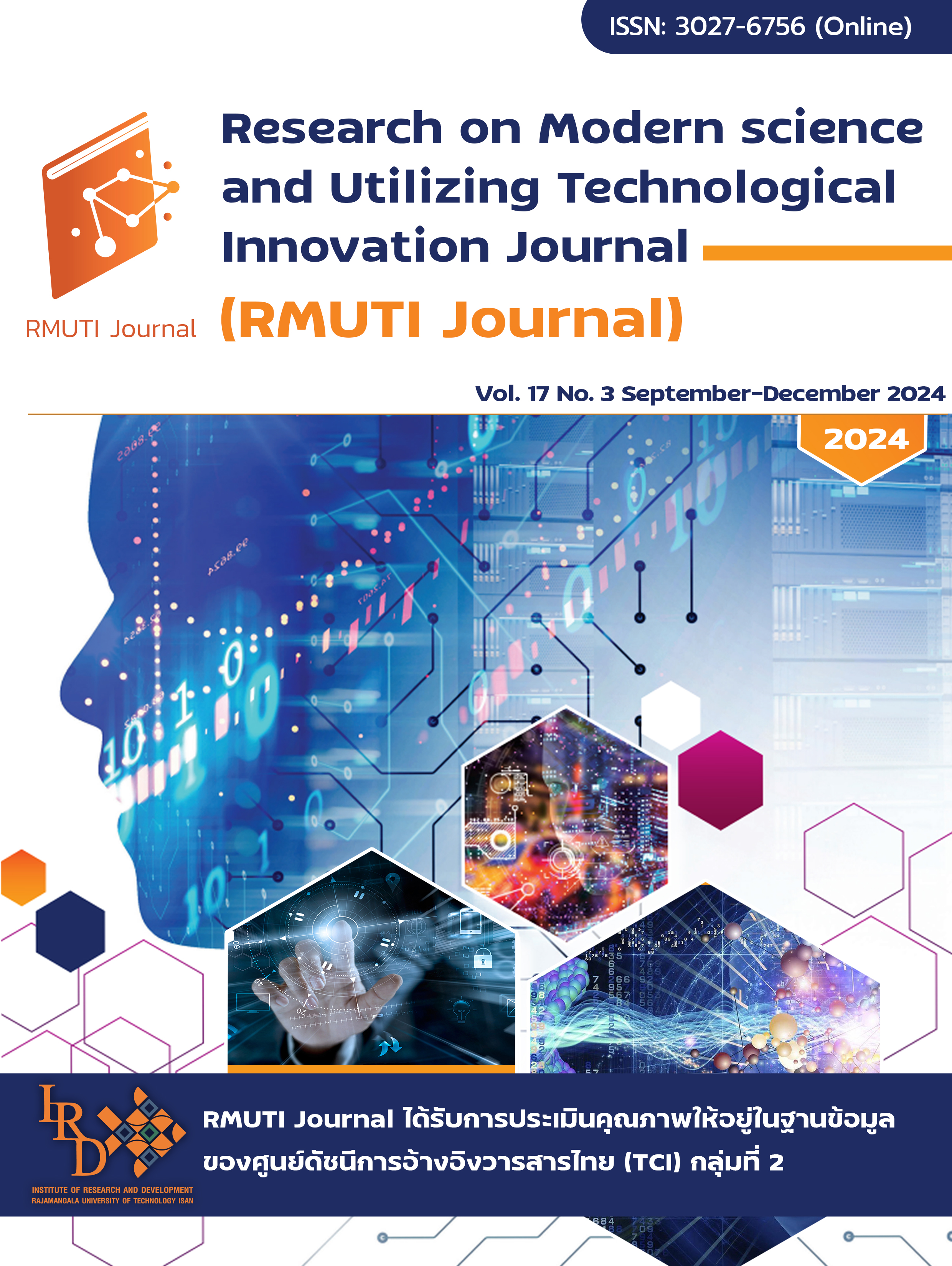Mechanical and Microstructural Properties of Geopolymer Paste from High Calcium Fly Ash Containing Basalt Fiber Powder from Waste Insulation
Main Article Content
Abstract
In this study, the properties of geopolymer paste from high calcium fly ash replaced by basalt fiber powder from insulation waste at the rates of 0, 10, 20, 30, and 40 wt% were evaluated. The activator with sodium silicate to sodium hydroxide (10 Molar) ratio (NS/NH) at 1.0 and the liquid to binder (L/B) ratio at 0.6 were used. The curing of the paste sample was conducted at room temperature. The setting time, compressive strength, flexural strength, and microstructure were tested. The results showed that all the geopolymer paste mixtures had SiO2/Al2O3 molar ratios between 3.79 and 4.49. The setting time of the paste was prolonged with increasing basalt fiber powder content. This is due to the reduction of calcium silicate hydrate (C-S-H) and calcium (alumino) silicate hydrate (C-(A)-S-H) in the mixture. The compressive strength of 20 % basalt fiber powder paste (BP20) gave the highest compressive strength with the compressive strength of 32.0, 53.6, and 68.0 MPa at the test ages of 7, 28, and 90 days, respectively. The flexural strength increased significantly with the increase in the amount of basalt fiber powder. In addition, replacing fly ash with basalt fiber powder at a ratio not exceeding 20 % helps the gel of geopolymer paste to form more new crystals, resulting in a denser structure that increases the paste's strength.
Article Details

This work is licensed under a Creative Commons Attribution-NonCommercial-NoDerivatives 4.0 International License.
References
Davidovits, J. (1991). Geopolymers. Journal of Thermal Analysis. Vol. 37, No. 8, pp. 1633-1656. DOI: 10.1007/BF01912193
Chindaprasirt, P., Jaturapitakkul, C., Chalee, W., and Rattanasak, U. (2009). Comparative Study on the Characteristics of Fly Ash and Bottom Ash Geopolymers. Waste Management. Vol. 29, Issue 2, pp. 539-543. DOI: 10.1016/j.wasman.2008.06.023
Punurai, W., Kroehong, W., Saptamongkol, A., and Chindaprasirt, P. (2018). Mechanical Properties, Microstructure and Drying Shrinkage of Hybrid Fly Ash-basalt Fiber Geopolymer Paste. Construction and Building Materials. Vol. 186, pp. 62-70. DOI: 10.1016/j.conbuildmat.2018.07.115
American Society for Testing and Materials. (2019). Standard Specification for Coal Fly Ash and Raw or Calcined Natural Pozzolan for Use in Concrete. ASTM C618-19. Annual Book of ASTM Standards.
Saptamongkol, A., Sata, V., Wongsa, A., Kroehong, W., Ekprasert, J., and Chindaprasirt, P. (2023). Hybrid Geopolymer Paste from High Calcium Fly Ash and Glass Wool: Mechanical, Microstructure, and Sulfuric Acid and Magnesium Sulfate Resistance Characteristics. Journal of Building Engineering. Vol. 76, 107245. DOI: 10.1016/j.jobe.2023.107245
American Society for Testing and Materials. (2019). Standard Test Methods for Time of Setting of Hydraulic Cement by Vicat Needle. ASTM C191-19. Annual Book of ASTM Standards.
American Society for Testing and Materials. (2020). Standard Test Method for Compressive Strength of Hydraulic Cement Mortars (using 2-in. or [50 mm] cube specimens). ASTM C109/C109M-20b. Annual Book of ASTM Standards.
American Society for Testing and Materials. (2021). Standard Test Method for Flexural Strength of Hydraulic-Cement Mortars. ASTM International. ASTM C348-21. Annual Book of ASTM Standards.
Chindaprasirt, P., De Silva, P., Sagoe-Crentsil, K., and Hanjitsuwan, S. (2012). Effect of SiO2 and Al2O3 on the Setting and Hardening of High Calcium Fly Ash-Based Geopolymer Systems. Journal of Materials Science. Vol. 47, No. 12, pp. 4876-4883. DOI: 10.1007/s10853-012-6353-y
Ziada, M., Erdem, S., Tammam, Y., Kara, S., and Lezcano, R. A. G. (2021). The Effect of Basalt Fiber on Mechanical, Microstructural, and High-Temperature Properties of Fly Ash-Based and Basalt Powder Waste-Filled Sustainable Geopolymer Mortar. Sustainability. Vol. 13, Issue 22, DOI: 10.3390/su132212610
Parveen, S. and Pham, T. M. (2020). Enhanced Properties of High-Silica Rice Husk Ash-Based Geopolymer Paste by Incorporating Basalt Fibers. Construction and Building Materials. Vol. 245, DOI: 10.1016/j.conbuildmat.2020.118422
Lee, W. K. W. and Van Deventer, J. S. J. (2002). The Effects of Inorganic Salt Contamination on the Strength and Durability of Geopolymers. Colloids and Surfaces A: Physicochemical and Engineering Aspects. Vol. 211, Issue 2-3, pp. 115-126. DOI: 10.1016/S0927-7757(02)00239-X
Yaseri, S., Hajiaghaei, G., Mohammadi, F., Mahdikhani, M., and Farokhzad, R. (2017). The Role of Synthesis Parameters on the Workability, Setting and Strength Properties of Binary Binder Based Geopolymer Paste. Construction and Building Materials. Vol. 157, pp. 534-545. DOI: 10.1016/j.conbuildmat.2017.09.102
Luo, Y., Li, S. H., Klima, K. M., Brouwers, H. J. H., and Yu, Q. (2022). Degradation Mechanism of Hybrid Fly Ash/slag Based Geopolymers Exposed to Elevated Temperatures. Cement and Concrete Research. Vol. 151, 106649. DOI: 10.1016/j.cemconres.2021.106649
Veerasingam, S. and Venkatachalapathy, R. (2014). Estimation of Carbonate Concentration and Characterization of Marine Sediments by Fourier Transform Infrared Spectroscopy. Infrared Physics & Technology. Vol. 66, pp. 136-140. DOI: 10.1016/j.infrared.2014.06.005
Yang, Y., Wang, B., Yuan, Q., Huang, D., and Peng, H. (2023). Characterization, Factors, and Fractal Dimension of Pore Structure of Fly Ash-Based Geopolymers. Journal of Materials Research and Technology. Vol. 26, pp. 3395-3407. DOI: 10.1016/j.jmrt.2023.08.157
Somna, K., Jaturapitakkul, C., Kajitvichyanukul, P., and Chindaprasirt, P. (2011). NaOH-activated Ground Fly Ash Geopolymer Cured at Ambient Temperature. Fuel. Vol. 90, Issue 6, pp. 2118-2124. DOI: 10.1016/j.fuel.2011.01.018


